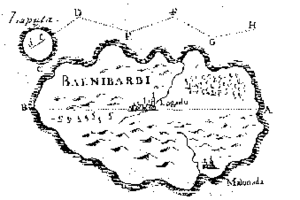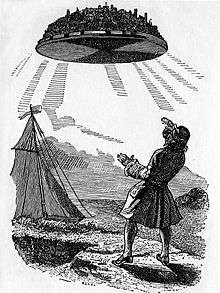Laputa
| Laputa | |
|---|---|
 Map of Laputa and Balnibarbi (original map, Pt III, Gulliver's Travels) | |
| Gulliver's Travels location | |
| Created by | Jonathan Swift |
| Genre | Satire |
| Type | Flying island |
| Notable characters | King |

Laputa is a flying island described in the 1726 book Gulliver's Travels by Jonathan Swift. It is about 4.5 miles in diameter, with an adamantine base, which its inhabitants can maneuver in any direction using magnetic levitation. It has a cave in the very centre which is precisely there to gather all the rainwater. It is also used by the king to enforce his supremacy.
Location
Laputa was located above the realm of Balnibarbi, which was ruled by its king from the flying island. Gulliver states the island flew by the “magnetic virtue” of certain minerals in the grounds of Balnibarbi which did not extended to more than four miles above, and six leagues beyond the extent of the kingdom[1], showing the limit of its range. The position of the island, and the realm below, is some five days' journey south-south-east of Gulliver's last known position, 46N, 183E[lower-alpha 1][2] (i.e. east of Japan, south of the Aleutian Islands)[3] down a chain of small rocky islands.[2]
Description
The island of Laputa is described as being exactly circular and 4.5 miles (7.2 km) in diameter, giving an area of 10,000 acres (4,000 ha). The island was 300 yards (270 m) thick, and comprised a bottom plate of adamant 200 yards thick, above which lay "the several minerals in their usual order", topped with "a coat of rich mould 10 or 12 ft deep". [4]
In shape the upper surface sloped down from circumference to centre, causing all rain to form rivulets into the centre where four large basins half a mile in circuit lie 200 yards from the absolute centre. [4] In the centre of the island itself was a chasm 50 yards in diameter continuing down into a dome extending 100 yards into the adamantine surface. This dome served as an astronomical observatory, and also contained the lodestone which enabled the island to fly and move above the realm. .[5]
Inhabitants

Laputa's population consists mainly of educated people, who are fond of mathematics, astronomy, music and technology, but fail to make practical use of their knowledge. Servants make up the rest of the population.
The Laputans have mastered magnetic levitation. They also are very fond of astronomy, and discovered two moons of Mars. (This is 151 years earlier than the recognized discovery of the two moons of Mars by Asaph Hall in 1877.) However, they are unable to construct well-designed clothing or buildings, because they take measurements with instruments such as quadrants and a compass rather than with tape measures.
Laputa is a male-dominated society. Wives often request to leave the island to visit the land below; however, these requests are almost never granted because the women who leave Laputa never want to return.
The clothes of Laputans, which do not fit, are decorated with astrological symbols and musical figures. They spend their time listening to the music of the spheres. They believe in astrology and worry constantly that the sun will go out. The Laputan houses, he notices, are badly built, without accurate right angles.
Due to their fervent intellectual pursuits, Laputans are also depicted as becoming so lost in thought that they cannot function in everyday life unless constantly struck by a bladder full of pebbles or dry peas, for which every one of them is escorted by one or two servants, so called "clappers". Many of their heads have become stuck reclined to one side, and they often suffer from strabismus: one eye turns inward and the other looks up "to the zenith." The Laputans' oddly-focused eyes are Swift's parodies of the microscope and telescope. So intent are the Laputans in their scientific studies that they cannot function in the everyday world, or even perceive it, and without their clappers, are in constant danger of running into a tree or a ditch when walking.
The Laputan women are highly sexed and adulterous, and, whenever possible, take on lovers out of visitors from the lands below. The Laputan husbands, who are so abstracted in mathematical and musical calculations, might assume their wives are adulterous, but so long as they have no clapper around, they won't notice the adultery even should it occur right before their eyes.
Nearby lands
The land beneath the floating island, within the region the Laputa can travel, is known as Balnibarbi. Balnibarbi is controlled by the king of Laputa; its ground capital is the city of Lagado.
Laputa's tyrannical king controls the mainland mostly by threatening to cover rebel regions with the island's shadow, thus blocking sunlight and rain, or by throwing rocks at rebellious surface cities. In extreme cases, the island is lowered onto the cities below to crush them, although this is not successful every time, notably in the case of Lindalino.
The Balnibarbian language, spoken on both Laputa and Balnibarbi, is described by Gulliver as sounding similar to Italian.
Symbolism
Lindalino's rebellion against Laputa is an allegory of Ireland's revolt against Great Britain, and Great Britain's (meaning the Whig government's) violent foreign and internal politics (see Jonathan Swift for his political career). The Laputans' absurd inventions mock the Royal Society.
As "la puta" means "the whore" (see Spanish profanity), some Spanish editions of "Gulliver's Travels" use "Lapuntu", "Laput", "Lapuda" and "Lupata" as bowdlerisations. It is likely, given Swift's education and satirical style, that he was aware of the Spanish meaning. (Gulliver claimed Spanish among the many languages in which he was fluent[6].)
Legacy
On Mars's largest moon, Phobos, there is one named regio, Laputa Regio, which is named after Swift's Laputa because of his 'prediction' of the two then undiscovered Martian moons, which his Laputan astronomers had discovered.[7]
Laputa, as with some of Swift's other inventions, was the inspiration and basis for many later works. Examples include:
- In volume three of James Blish's Cities in Flight tetralogy, Earthman, Come Home (1955), mayor Amalfi refers to IMT'a attacks as being similar to Laputa.
- William Barrett used the story in his 1958 book Irrational Man to illustrate the alienation which existentialism tries to counter.
- In Stranger in a Strange Land (1961), Robert Heinlein describes Laputa's system for managing communication through the use of the climenole, or flapper.
- In the Oscar-winning movie Dr. Strangelove (1964) a loose B-52 bomber is targeting the Laputa ICBM complex in Siberia. This is both a referral to Swift's novel and a sexual innuendo, among many others in the movie.
- Case for a Rookie Hangman (1969), Czech film by Pavel Juráček [8]
- The Star Trek: The Original Series episode "The Cloud Minders" (1969) features a floating city.
- The post-apocalyptic science fiction novel Engine Summer (1979) by John Crowley features a flying city called Laputa.
- The flying party in a building in Douglas Adams' Life, the Universe and Everything (1982) is a part of the Gulliver's Travels theme running through the Hithchhikers' Guide to the Galaxy series.
- Laputa: Castle in the Sky (1986), an anime by Hayao Miyazaki, which centres on a floating city. It also gave its name to a race course of the Game Boy Advance video game F-Zero: Maximum Velocity, as "Laputan Colony". In both titles, the North American release changed these titles, to simply "Castle in the Sky" and "Empyrean Colony" respectively, to avoid similarities to the vulgar Spanish term la puta.
- The "Kingdom of Zeal" in Chrono Trigger (1995) heavily resembles Laputa.
- The Stargate SG-1 episode "The Nox" (1997) features a floating city.
- The Mazda Laputa (1999), whose name derives from Gulliver's Travels.
- The video game Deus Ex (2000) features a biomechanically augmented character, Gunther Hermann, whose 'killphrase' is "Laputan Machine". Uttering the phrase to the character causes his death.
- In the video game, The Elder Scrolls III: Morrowind (2002), the floating prison "Ministry of Truth" was often thought to be based on Laputa and George Orwell's Nineteen Eighty-Four.
- The video game PoPoLoCRois (2005) including a location called the floating continent of 'Bryonia' based on Laputa.
- In the video game UFO: Aftershock (2005), the player uses a flying alien city as their base for the purposes of retaking control over a post-apocalyptic Earth, with the base referred to as a "Laputa".
- The video game BioShock Infinite (2013) features a dystopian flying city.
- The film Elysium (2013) included an orbiting (flying) utopia managing advanced technology.
- The album Choose Your Weapon (2015) by Hiatus Kaiyote features a song entitled "Laputa."
- The album "Coming to You Live" (2017) by Korean artist DPR Live features a song titled "Laputa" featuring Crush (singer).
- The video game Xenogears represents the concept in one of the opposing nations, the Ariel City Shevat.
Notes
- ↑ That is, 177 West.
References
- ↑ Swift 2008, p. 157.
- 1 2 Swift 2008, p. 143.
- ↑ Swift 2008, p. 319.
- 1 2 Swift 2008, p. 154.
- ↑ Swift 2008, p. 155.
- ↑ Swift, Jonathan (1900). Gulliver's Travels Into Several Remote Regions Of the World. BOSTON NEW YORK CHICAGO: D.C. HEATH & CO., PUBLISHERS. pp. Part I, Chapter II.
- ↑ Gazetteer of Planetary Nomenclature USGS Astrogeology Research Program, Phobos
- ↑ Pripap pro Začínajícího kata, Rotterdam: Film festival .
Sources
- Page, Michael; Ingpen, Robert (1998). Encyclopedia of Things That Never Were. New York: Penguin Studio. pp. 94, 150–1. ISBN 0-14-010008-3.
- Swift, Jonathan (2008) [1986], Gulliver's Travels, Oxford World Classics, introduction by Claude Rawson, explanatory notes by Ian Higgins (reprint ed.) . First published 1726.
External links
| Wikisource has the text of the 1905 New International Encyclopedia article Laputa. |